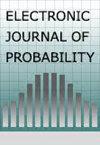遗传元件拷贝数变异的二倍体群体模型
IF 1.1
3区 数学
Q2 STATISTICS & PROBABILITY
引用次数: 0
摘要
我们研究了以下恒定大小$N$的二倍体种群的模型:每个个体都携带随机数目的(遗传)元素。在繁殖事件中,两个亲本中的每一个都以概率$\trac 12$独立地将每个元素传递给后代。我们研究了过程$X^N=(X^N(1),X^N(2),…)$,其中$X_t^N(k)$是在时间$t$携带$k$元素的个体的频率,并证明$X^N$与其经验第一矩$Z^N$联合收敛于“慢-快”系统$(Z,X)$,其中$X_t=\text{Poi}(Z_t)$和$Z$根据关键的Feller分支过程演化。我们讨论了解释这一发现的启发式方法以及一些扩展和限制。本文章由计算机程序翻译,如有差异,请以英文原文为准。
A diploid population model for copy number variation of genetic elements
We study the following model for a diploid population of constant size $N$: Every individual carries a random number of (genetic) elements. Upon a reproduction event each of the two parents passes each element independently with probability $\tfrac 12$ on to the offspring. We study the process $X^N = (X^N(1), X^N(2),...)$, where $X_t^N(k)$ is the frequency of individuals at time $t$ that carry $k$ elements, and prove convergence (in some weak sense) of $X^N$ jointly with its empirical first moment $Z^N$ to the ``slow-fast'' system $(Z,X)$, where $X_t = \text{Poi}(Z_t)$ and $Z$ evolves according to a critical Feller branching process. We discuss heuristics explaining this finding and some extensions and limitations.
求助全文
通过发布文献求助,成功后即可免费获取论文全文。
去求助
来源期刊

Electronic Journal of Probability
数学-统计学与概率论
CiteScore
1.80
自引率
7.10%
发文量
119
审稿时长
4-8 weeks
期刊介绍:
The Electronic Journal of Probability publishes full-size research articles in probability theory. The Electronic Communications in Probability (ECP), a sister journal of EJP, publishes short notes and research announcements in probability theory.
Both ECP and EJP are official journals of the Institute of Mathematical Statistics
and the Bernoulli society.
 求助内容:
求助内容: 应助结果提醒方式:
应助结果提醒方式:


